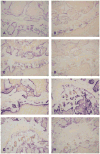The Effects of Storage Conditions on the Preservation of Enzymatic Activity in Bone
- PMID: 20686670
- PMCID: PMC2913480
- DOI: 10.1179/his.2008.31.4.169
The Effects of Storage Conditions on the Preservation of Enzymatic Activity in Bone
Abstract
Alkaline phosphatase and acid phosphatase are two major enzymatic measures of osteoblastic and osteoclastic activity, respectively. As a result, the preservation of the enzymes in bone specimens to near in vivo accuracy is essential. Despite standardization of the staining process, several factors related to the storage of blocks and slides before sectioning and staining impact the level of enzymes detected in the tissue. Block condition (intact, faced, or unstained) as well as environment (temperature and length of time in storage) affect alkaline phosphatase preservation while the acid phosphatase enzyme remains unaffected. We conclude that to optimally preserve alkaline phosphatase enzyme, methacrylate-embedded undecalcified murine bones should be stored as intact blocks. After sectioning, the faced blocks should be stored at 4°C for optimal enzyme staining of future sections. Furthermore, it is best to stain sections immediately after sectioning.
Figures


Similar articles
-
Loss of tumor marker-immunostaining intensity on stored paraffin slides of breast cancer.J Natl Cancer Inst. 1996 Aug 7;88(15):1054-9. doi: 10.1093/jnci/88.15.1054. J Natl Cancer Inst. 1996. PMID: 8683636
-
Processing and Sectioning Undecalcified Murine Bone Specimens.Methods Mol Biol. 2021;2230:231-257. doi: 10.1007/978-1-0716-1028-2_14. Methods Mol Biol. 2021. PMID: 33197018
-
Staining and histochemistry of undecalcified bone embedded in a water-miscible plastic.Stain Technol. 1980 Sep;55(5):313-21. doi: 10.3109/10520298009067260. Stain Technol. 1980. PMID: 6162250
-
Enzyme histochemistry of undecalcified bone and cartilage embedded in glycol methacrylate.Acta Histochem. 1975;53(2):198-202. Acta Histochem. 1975. PMID: 171907
-
Histological methods to determine blood flow distribution with fluorescent microspheres.Biotech Histochem. 1998 Nov;73(6):291-309. doi: 10.3109/10520299809141123. Biotech Histochem. 1998. PMID: 9888355 Review.
Cited by
-
Optimized assay and storage conditions for enzyme activity profiling of ectomycorrhizae.Mycorrhiza. 2011 Oct;21(7):589-600. doi: 10.1007/s00572-011-0364-4. Epub 2011 Feb 23. Mycorrhiza. 2011. PMID: 21344212
-
Blood clot formation does not affect metastasis formation or tumor growth in a murine model of breast cancer.PLoS One. 2014 Apr 16;9(4):e94922. doi: 10.1371/journal.pone.0094922. eCollection 2014. PLoS One. 2014. PMID: 24740307 Free PMC article.
References
-
- Gomori G. Microtechnical determination of phosphatase in tissue sections. Proc Soc Exp Biol Med. 1939;42:23–29.
-
- Jacoby F, Martin BF. The histochemical test for alkaline phosphatase. Nature. 1949;163:875. - PubMed
-
- Pearse AGE. Histochemistry, Theory and Applied. 3. Boston: Little Brown; 1968.
-
- Morrison GR, Karl IE, Schwartz R, Shank RE. The quantitative histochemistry of the normal human liver lobule. J Clin Lab Med. 1965;65:248–256. - PubMed
Grants and funding
LinkOut - more resources
Full Text Sources
Research Materials
